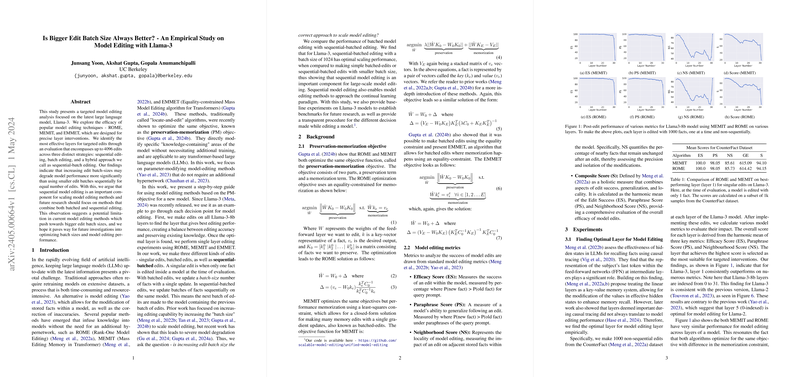Model Editing Techniques for Llama-3 LLM
Overview of LLM Editing
LLMs like Llama-3 are incredibly versatile tools in AI, employed across various domains including translation, content generation, and more. However, keeping these models updated and accurate poses significant challenges. Model editing is a method that attempts to tweak an existing model to correct errors or update its knowledge base without full retraining, which is resource-intensive. This blog post explores an insightful analysis of different model editing techniques namely ROME, MEMIT, and EMMET, as applied to the Llama-3 model.
Selection of Model Editing Techniques
- ROME: Rank-One Model Editing, aimed at tuning model parameters directly to incorporate new facts while preserving old knowledge.
- MEMIT: Mass Editing Memory in Transformer, similar in goal to ROME but employs a different technical approach, allowing batch updates.
- EMMET: Focuses on batch edits but uses an equality-constraint method, which theoretically preserves information better in large-scale edits.
Each of these techniques optimizes what's known as the preservation-memorization (PM) objective, which balances adding new information while maintaining existing knowledge.
Experimental Setup
The paper evaluates the effectiveness of these editing strategies across different experimental setups:
- Single Layer Editing: Identifying the most effective model layer for edits.
- Batch versus Sequential Editing: Comparing performance between editing many items at once versus one after the other.
The effectiveness was measured using several metrics:
- Edit Success (ES): How well the model adopts the new fact in place of the old.
- Paraphrase Success (PS): The model's ability to generalize the new information across different phrasings.
- Neighborhood Success (NS): How localized the edit effects were, aiming for minimal disruption.
- Composite Score (S): A combined metric for overall editing quality.
Key Findings and Observations
Optimal Layer Identification
Instead of editing across all layers, pinpointing a specific layer can lead to better performance. The paper found that for Llama-3, the first layer provided the best balance across all evaluation metrics, differing from some earlier models where middle layers performed better.
Batch vs. Sequential Editing
- Batch Editing: Larger batches of edits (e.g., more than 1024 facts simultaneously) generally resulted in poorer performance across most metrics, particularly affecting the NS score, which measures the impact of edits on adjacent facts.
- Sequential Editing: Smaller batches or individual edits added sequentially tend to preserve model performance better. It was found that sequential-batched editing, combining elements of both approaches, provided the most promising results in terms of scalability and efficiency.
Practical Implications
For practitioners and researchers, this paper underscores the importance of choosing the right editing strategy based on the specific requirements of an LLM application. Sequential or small-batch edits, while potentially slower, offer more controlled updating and may preserve model integrity better than large-scale batch edits. The findings bolster the idea of a hybrid approach, integrating benefits from both types of edits for LLMs like Llama-3.
Future Directions
Future research might explore more refined hybrid editing techniques or look into automated methods to dynamically determine the optimal editing strategy in real-time. Another potential area is the development of new metrics that can capture more nuanced effects of model edits, thereby aiding in more granular optimizations.
In summary, this paper contributes a detailed examination of how different editing techniques affect the performance of a high-capacity LLM, providing a clear pathway for further innovations in model editing methodologies.
